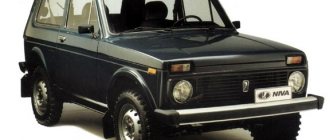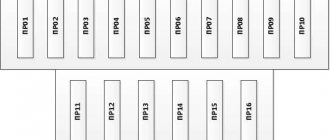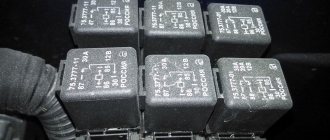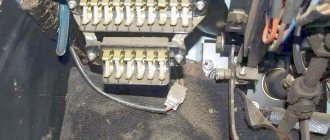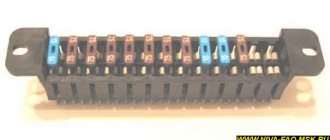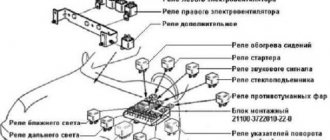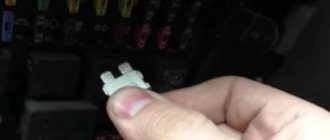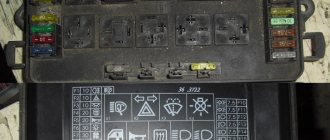- December 23, 2015 LadaOnline 464 458 Modern AvtoVAZ SUVs use injection power units. If a malfunction is detected in the electrical equipment of the car, you should first check the serviceability of the fuses and relays. Next, we will show where the mounting block is located (fuse box or black box), as well as the location of the elements inside it.
Location of fuse and relay blocks Lada 4×4
The main part of the fuses is located in the interior of the Lada 4×4 under the panel to the left of the steering column. Total 4 blocks:
1 — engine control system fuse box; 2 — windshield wiper relay; 3 — fuse blocks; 4 — relay block of the engine control system.
The fourth relay block is located above the gas pedal.
Main and additional fuse blocks
These two blocks are connected to each other. There are 10 fuses in the upper block, and 6 in the lower one. Markings from left to right:
Heater fan, rear window defroster, rear wiper and washer system, windshield washer pump
Steering column switch, windshield wipers, hazard warning lights, breaker relay (in turn signal mode), reverse light, instrument cluster (coolant temperature gauge, fuel level gauge, tachometer, warning lights: turn indicators, differential lock, parking brake, emergency condition of the working brake system, insufficient oil pressure, fuel reserve, battery charge)
Left headlight (high beam), high beam indicator lamp
Right headlight (high beam)
Left headlight (low beam)
Right headlight (low beam)
Side light lamps in the left front and left rear lights, license plate lights, side light indicator lamp
Side light lamps in the right front and right rear lamps, backlight lamps for the instrument cluster, cigarette lighter, switches, heating and ventilation control unit
Hazard switch, breaker relay (in hazard mode), heated tailgate glass relay contacts
Sound signal, interior lamps, brake lamps in the rear lights
Fog light relay contacts in rear lights
Additional fuse circuits in the Urban package:
Fuse number and rating
Electric windows for front doors Electric side mirrors
Air conditioning fan, air conditioning compressor
Side mirror heaters
Central interior lamp
Air conditioning fan, air conditioning compressor
Lada Niva engine management system fuses
| F1 (30A) | Right electric fan relay contacts |
| F2 (30A) | Left electric fan relay contacts |
| F3 (15A) | Relay windings of the right and left electric fans, controller, injectors, ignition coil |
| F4 (15A) | Heating elements for control and diagnostic oxygen concentration sensors, phase sensor, mass air flow sensor, canister purge valve |
Mounting blocks for Lada 4×4 2018
The main and additional units are located in the cabin to the left of the steering wheel, under the instrument panel. The blocks contain fuses of the “Cylinder” size, ten and six fuses, respectively. The ratings and purpose of the fuses are indicated in Table 4 “Circuits protected by fuses”:
Fuse block of standard size “Standard”. The block is located on the left side under the upholstery and contains fuses that are designed to protect engine control system devices. The ratings and purpose of the fuses are shown in Table 5:
The fuse and relay box is located on the left side of the steering column under the instrument panel. The block contains two “Standard” size fuses, which are designed to protect the circuits of the electric fuel pump, electric windows and electric mirrors. The ratings and purpose of the fuses are shown in Table 6:
The fuse and relay box is located on the right side of the steering column under the instrument panel. The block contains one “Maxi” size fuse and two “Standard” size fuses, which are designed to protect the circuits of the hydraulic unit of the anti-lock braking system. The ratings and purpose of the fuses are shown in Table 7:
Replacing the block
In case of burnout or mechanical damage, it is necessary to repair the unit by replacing its components or the entire assembly.
To replace the main unit, follow these steps:
- Disconnect the battery from the on-board network.
- Remove the box cover and unscrew the two 8 mm nuts securing the block. Then you need to pull the box towards you and remove it from the fastening studs.
- Write down the markings and position of the wires on the old unit.
- Disconnect the cables from the plugs of the old unit and connect them in the same sequence on the new one.
- Check fuse ratings and wire installation.
- Secure the replaced block with nuts.
- Connect power to the on-board network and check the functionality of the circuits.
Mounting blocks for Lada 4×4 2020
The turn signal relay (part number 8450082700, 9-pin), as well as the windshield wiper relay, are located under the trim in the driver’s feet, to the left of the fuse mounting block.
Attention!
The relay and fuse diagram may differ depending on the configuration and production date of the vehicle. Current diagrams of the mounting block are presented in the operating manual for the date of manufacture of the car (download from the official website for 3-door or 5-door).
Why does a fuse or light relay or any other constantly blow out? Before replacing it with a similar one, you must first find and eliminate the cause of its burnout. This could be a short circuit, incorrectly selected rated current, etc. Use electrical circuit diagrams to troubleshoot problems. Questions on this topic can be asked on the forum.
Relay and fuse diagram for VAZ Niva
Car owners are well aware that the VAZ 21214, 21213 (Niva) fuse box is a critical detail that requires detailed study. Knowledge of the electrical circuit allows you to avoid many problems and carry out timely diagnosis of breakdowns. Since the family has existed for many decades, it has managed to go through a number of radical changes - the transition from carburetor to injection engines, for example. This did not entail a radical change in the location and content of the mounting blocks, of which there are two in the cabin and one under the hood.
Types of fuses
Over the entire period of its existence, this segment of car elements has changed more than one type. The most common ones are:
ceramic;
Flat fuses are considered a relatively new type. They are used in almost all new cars. They became widespread due to their increased level of reliability and relatively low cost.
The next item will be ceramic fuses, which used to be very popular, but have lost their position due to low efficiency.
The oldest of all types of fuses are glass. They are small cones made of glass. This type of fuses is practically not used today due to the low level of reliability.
These are the most common types of fuses, however, there are others, but less popular.
VAZ Niva fuse diagram for injector
The Niva with fuel injection has today almost completely replaced the carburetor models of the family. With the transition to a new injection system, the manufacturer tried to minimize the inconvenience for the car owner and not radically change the location of the mounting blocks, as well as their filling with protective elements. Traditionally, there are two of them in the cabin. Another one, in the back, is responsible for controlling the engine.
Fuse box VAZ 21214 Niva with description
Both blocks are connected to each other. The total number of fuses in the upper one is ten, while at the bottom there are six, including reserve ones.
Description of the camshaft sensor on Niva Chevrolet
On engines with a carburetor fuel system, the role of the DPRV is played by the distributor. The design of the injector is different, the system was parallelized, injection and ignition were done in pairs.
During systematic operation, the household equipment wears out and becomes unusable. The process of self-replacement is not at all difficult. The task is feasible for a car enthusiast without technical equipment maintenance skills.
To determine which cylinder is on stroke, the electronic engine control unit controls the position of the camshaft using DPRV (SMR)
Data from the sensor is extremely important for setting and dosing fuel, sparks in the combustion chamber, and injectors. The camshaft sensor directly affects fuel consumption, acceleration dynamics, and the amount of emissions in the exhaust gases.
In cars, including Niva Chevrolet, magnetic and Hall effect sensors are preinstalled. Both types are designed to read and transmit data to the electronic engine control unit.
The latter, based on the analysis of indicators, adjusts the fuel supply, ignition timing, and spark frequency.
- The magnetic controller produces its own alternating current. The design has two contacts;
- The Hall effect controller has one contact, powered from a third-party source.
Signs of DPRV malfunction:
- Unstable engine operation at idle speed;
- After stopping, the engine starts again;
- Increased fuel consumption;
- Power reduction;
- Passive acceleration dynamics;
- On the dashboard there are system error indicators (see photo);
- The gearbox can be locked in one position until it comes to a complete stop and the ignition is turned off. Single or cyclic action;
- The car moves jerkily;
- The maximum speed of the car is limited to 65 – 85 km/h;
- Periodically the engine stalls;
- Misfires when turning on the ignition;
- Inability to restart the engine.
Frequent causes of premature wear of the controller:
- Natural factor due to long-term use;
- Mechanical damage to the controller housing;
- Open circuit;
- Short circuit of contacts;
- Sensor breakage due to impact, accident;
- Malfunctions of the electronic engine control unit.
| Name / catalog article | Price in rubles |
| Automega 150097810 | From 800 |
| JP group 1191400200 | From 800 |
| EPS 1953071 | From 800 |
| Delphi SS10814 | From 800 |
| Meyle 3148000038 | From 800 |
Preparatory stage:
- Key to "10";
- New controller;
- Rags;
- Phillips screwdriver;
- Additional lighting is optional.
Step by step guide:
- Open the hood;
- We release the metal clamp - the tie from the rubber pipe of the air duct. We extract it;
- At the top of the block we find the controller, remove the terminals, unscrew the bolt to “10”;
- We remove the sensor and replace it with a new one;
- We put on the terminals and install the air duct pipe.
Fuse diagram for carburetor VAZ Niva
The only difference between Niva mounting blocks with injection and carburetor systems is related to the block. It is located under the hood of the car in a compartment specially designated for this purpose. His diagram looks like this:
Location of fuses Niva 21213
This scheme is relevant for all models of the family produced from 1997 to 1999.
Where are the relays located in the field?
In this article I will tell you where the relays are located in the field. Electronic devices and units of the VAZ 2121 car are powered by a voltage of 12 volts. Each element is designed for a precise load, so the current can be tens of milliamps or hundreds of amperes. If power is supplied from control devices to actuators with operating parameters, the car will be entangled in thick cable bundles.
For example, consider connecting fan motor .
From the control unit (4) a low-current signal is supplied to control switches 2, 6, 8. For this, thin wires located in the common control harness are used. Relay coils consume little, and can be energized as long as desired. The operating current is switched to the consumer using power contacts.
From the battery terminal (c) through the fuse (3), voltage is supplied via the power wire
to power the fan motors .
Removal and replacement process
In order to replace a blown electrical fuse, special knowledge and skills are not required. Everything is very simple.
Required Tools
To work, we will need the most common tools that any driver always has at hand, namely:
- a set of new electrical fuses;
- a set of keys;
- screwdriver.
A set of keys that every car enthusiast should have
Stages
- Before starting replacement work, you need to disconnect the negative battery cable.
- Next, using a screwdriver, unscrew the screws that secure the casing and remove it.
- We look at the diagram to see where the blown fuse is located.
- We find it in the block and remove it.
- We take the same one at face value and install it in place of the extracted one.
- Attention! On the back of the block there is an electric fan fuse with a rating of 30 A, its body is painted green. The other elements are rated 15A and are blue.
- If we do not plan to change the block, then the work is finished and all we have to do is install the casing in place and secure it with screws.
- But if you decide to put the system with fuses in order and replace the old block with a new one, then we need to use an 8-mm socket to unscrew a couple of nuts that secure the block.
- Now we remove the block itself.
- Disconnect the block with wires.
- We change the block.
- We install fuses in it.
- We secure it with nuts.
- We return the casing to its place and tighten the screws.
- This completes the work with electrical fuses on the VAZ 2121 Niva.
Attention! If the fuse blows again, then it is necessary to look at the entire circuit, and specifically at the consumer for which this fuse element is responsible.
Never use homemade jumpers or a fuse of a different rating instead of a blown one.
This video uses the example of a VAZ six to show some reasons for replacing the block. As you can see, during operation the body was deformed and melting was noticeable.
Like the video, everything is very simple in terms of time; such work will take no more than half an hour, instead of two or three hours of standing at a service station and spending extra money.
Where are the relays located in Niva
The relay blocks in the VAZ 21213 car are located in the steering wheel area. The first fuse box is located on the left under the instrument panel.
By dismantling it, you gain access to the engine control switching unit. The relays are located there:
- Ignition
- Fan motors (2 pcs)
- Turning on the fuel pump
- Main switch
Relay block for engine control system VAZ 2121, 21213, 21214
| №1 | Ignition relay |
| №2 | Main relay |
| №3 | Right cooling fan relay |
| №4 | Left cooling fan relay |
| №5 | Fuel pump relay (fuel) |
| №6 | Fuel pump fuse F5, 15A |
In some vehicle configurations, under the additional unit next to the ignition relay there is a starter relay.
